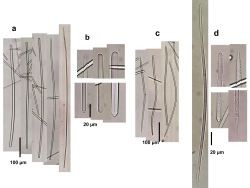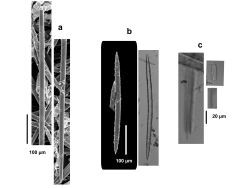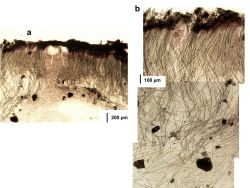yellow
orange-yellow
encrusting
massive
crumbly
soft
Bahamas
Belize
Colombia
Martinique
Panama
Myrmekioderma rea
Description: This species grows filling cavities in reef hard substratum or is buried in sand and rubble, sometimes with slightly elevated lobes, reaching overall 30-50 cm in diameter, and several cm thick; at Martinique and Panama there were massive specimens growing exposed on the reef. When buried, only the oscular areas are barely seen, with the surface as a stretched membrane with fields of oscules over confluent exhalant canals; in lobes, oscules can be at the top, single or in groups, usually less than 1 cm in diameter, although sometimes they can be seen as long sinuous or meandering bands, ca. 5 mm wide, from which strands of tissue are stretched from side to side, the spaces conforming the oscules. Buried surfaces or free sides have thin (1-2 mm wide) circular grooves. These elevated areas in between grooves tend to be circular and are heavily fouled, and become wart-like when specimens contract upon handling and fixation. Color of the tissue orange-yellow. Consistency toughly compressible, but more easily damaged than the preceding species, especially in the buried portions. Skeleton structure (only analyzed in a Bahamian specimen) not very dense, as loosely packed ascending tracks of spicules (mostly of the spined type), more densely packed in the outer portions, where there is a cortex packed with foreign material. Foreign debris also tends to accumulate at the base. Grooves appear as subsuperficial round canals, some 200 µm in diameter, followed below by areas of tissue free of skeleton. Spicules in three types: (1) Anysostrongyles (styloids) to styles. In the Bahamas these are anysostrongyles with one round or mammiform side, and the other narrower roundish, blunt or mammiform, 380-850 µm long by 5.5-12.5 µm wide. In Colombia (see Valderrama & Zea, 2014), Martinique and Panama these are true styles with slightly blunt tips (with a few anysostrongyles), 735-1130 long by 7.7-19.4 µm wide. (2) Strongyles to anysostrongyles to oxea, minutely spined. In the Bahamas these are slender, sinuous mostly anysostrongyloid, with a few oxeote, spined all over but less towards the center, 195-470 µm long by 5.5-9.0 µm wide. In Martinique, Colombia and Panama, they are only oxeote, slightly curved, thicker and with stouter spines which are also concentrated on the outer ends, 299-380 µm long by 8.6-14.3 µm wide. (3) Raphides, which were not found in the Bahamian specimens, in two or three size categories, often in bundles (trichodragmata), 93-133 x 5.7-11.9, 38-62 x 9.5-11.9 µm, and 19-29 x 4.8-9.5 µm (measurements from Valderrama & Zea, 2014).
Notes: This is a shallow and deep reef species, found more often deep, usually filling crevices of the reef (both exposed and cryptic) or buried in sand an rubble; it can also occur in sea-grass beds. Myrmekioderma styx de Laubenfels, 1953, is a junior synonym of M. rea (S.Z. examined the types). The former name was used erroneously by several Caribbean authors for M. gyroderma (Alcolado, 1984), also pictured here. M. rea may co-exists sympatrically with M. gyroderma in reefs, but it is distinguished from the latter partly for its growth form (usually cavity-filling and cryptic in M. rea, massive and exposed in M. gyroderma, although the former may be massive and live exposed in some areas such as Martinique and Bocas del Toro in Panama), the circular grooves (elongated and meandering in M. gyroderma), and in having thinner styles to anysostrongyles instead of oxeas as principal spicules. A third species, recently described from the tropical eastern Brazil, Myrmekioderma intrastrongyla Sandes & Pinheiro, 2013, has strongyles like our material from the Bahamas; these species should be more closely compared in light of our findings. Myrmekioderma rea can also be confused with Didiscus oxeata, also pictured here. Both have an overall aspect of fouled surface pierced by with orange-yellow grooves, which could also be rounded although wider in D. oxeata; the latter is massive, with cylindrical lobes that have wide oscular areas on top; the presence of unique discorhab spicules next to stout oxea makes this species distinct.
Author Reference: (de Laubenfels, 1934)
Link: World Porifera Database

![<i>Myrmekioderma rea</i> <br />[Bahamas, Sweetings Cay]](mini/00121/00690.jpg)
![<i>Myrmekioderma rea</i> <br />[Bahamas, Sweetings Cay]](mini/00030/01065.jpg)
![<i>Myrmekioderma rea</i> <br />[Belize, Pelican Cays]](mini/00115/01874.jpg)
![<i>Myrmekioderma rea</i> <br />[Belize, Pelican Cays]](mini/00115/01875.jpg)
![<i>Myrmekioderma rea</i> <br />[Colombia, Santa Marta]](mini/00115/01890.jpg)


